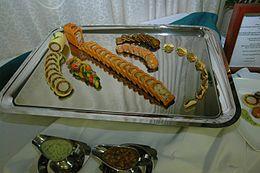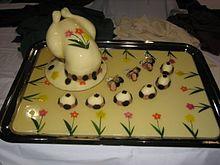
A garde manger (pronounced [gaʁd mɑ̃ʒe]; French for "keeper of the food") is a cool, well-ventilated area where cold dishes (such as salads, hors d'œuvres, appetizers, canapés, pâtés, and terrines) are prepared and other foods are stored under refrigeration. The person in charge of this area is known as the chef garde manger or pantry chef. Larger hotels and restaurants may have garde manger staff to perform additional duties, such as creating decorative elements of buffet presentation like ice carving and edible centerpieces.
History
The term garde manger originated in pre-Revolutionary France. At that time, maintaining a large supply of food and beverage was an outward symbol of power, wealth, and status. It is because of this duty of supervising the preserving of food and managing its utilization that many interpret the term garde manger as "keeping to eat".
The term garde manger is also related to the cold rooms inside castles and manor houses where the food was stored. These food storage areas were usually located in the lower levels, since the cool basement-like environment was ideal for storing food. These cold storage areas developed over time into the modern cold kitchen.[1]
Most merchants who worked outside noble manors at this time were associated with a guild, an association of persons of the same trade formed for their mutual aid and protection. Guilds would develop training programs for their members, thereby preserving their knowledge and skills. Charcuterie was the name of a guild that prepared and sold cooked items made from pigs. Through this organization, the preparation of hams, bacon, sausages, pâtés, and terrines were preserved. When the guild system was abolished in 1791 following the French Revolution of 1789, garde mangers took on the responsibility for tasks that had formerly been performed by charcutieres, who had difficulty competing with the versatile garde mangers due to the limited range of skills involved.
The position of "butcher" first developed as a specialty within the garde manger kitchen. As both the cost of and demand for animal meats increased, more space was required for the task of fabricating and portioning the raw meats. This increased need for space was due not only to an upswing in the volume of meat sales, but also to the need for separating raw meats from processed foods to avoid cross-contamination and the resulting possibility of foodborne illness.
Modern Garde manger
Modern Garde manger can refer to different things in the professional kitchen. In many restaurants, it is a station which is generally an entry-level cooking position within a restaurant, as it often involves preparing salads or other smaller plates which can be heated and quickly plated without significant experience. In other high-profile classically influenced restaurants and hotels, the position pertains to the classical preparations, which often include pâtés, terrines and elaborate aspics.
See also
- Brigade de cuisine
- Garnish (food)
- Food presentation
- List of restaurant terminology
- Pantry
References
- ^ Garlough, Robert B.; Campbell, Angus (2012-11-16). Modern Garde Manger: A Global Perspective. Cengage Learning. ISBN 1133715117.
- Food production operation and management : Aman Publisher India
- Culinary Institute of America. Garde Manger: The Art and Craft of the Cold Kitchen ISBN 0-7645-7663-1
